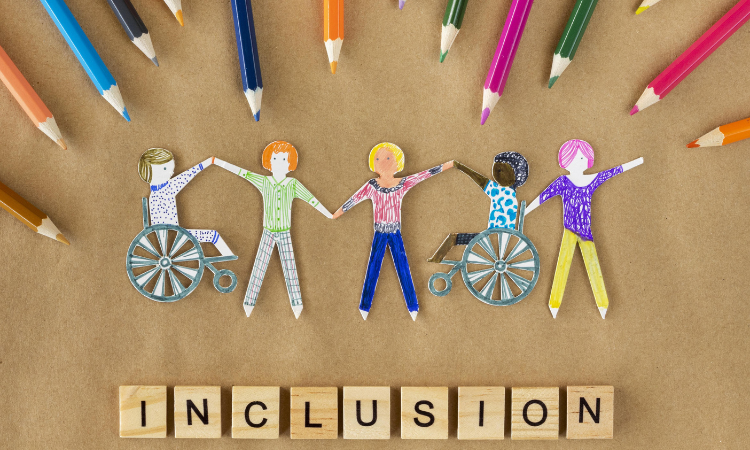The Pyramid Model holds high expectations for EVERY CHILD and intentionally promotes participation in ALL learning and social activities for ALL children, facilitated by individualised accommodations. Pyramid Model practices increases the social-emotional competencies of all children, of the group as a whole, and of children with behavioural challenges.

Image sourced from Community Early Learning Australia
The National Center for Pyramid Model Innovations together with Early Childhood Technical Assistance Center in the USA, outline a series of 9 indicators which detail the key elements believed to be necessary for implementing high-quality inclusive practices in early childhood settings. They are the only set of inclusion indicators which are based on implementation science.
They include:
- Promotion and Affirmation of Individual Differences
- Family Partnerships
- Social Emotional Learning and Development
- Meaningful Interactions with Peers
- Curriculum
- Instruction
- Collaborative Teaming
- Assessment
- Culturally Responsive and Identity Affirming Practices
Promotion and Affirmation of Individual Differences
Personnel promote acceptance and appreciation of children’s individual differences and their varying abilities, with a focus on children’s strengths and contributions to an enjoyable, engaging and positive learning environment.
Family Partnerships
Personnel develop authentic and culturally responsive relationships with families that involve daily communication about children’s learning and development and frequent celebrations of the child. Families have multiple and varied opportunities to provide input into their child’s learning and supports.
Social Emotional Learning and Development
Personnel foster positive and culturally responsive adult-child relationships, establish predictable routines, and intentionally teach a range of social emotional skills. When children engage in challenging behavior, a team-based approach is used to understand what the child is communicating, how to adapt the environment, and what social emotional skills to teach and/or strengthen.
Meaningful Interactions with Peers
Personnel use various strategies to promote interactions between children without disabilities and children with disabilities. This includes organizing the environment for positive social interaction and teaching specific social skills that promote peer interactions among all children, encourage peer interactions with multiple exchanges, and increase the complexity of peer interactions.
Curriculum
Personnel develop, modify, and implement teaching plans that optimize the amount of time children with disabilities spend engaged in activities, such as small and large group play, and other routines, such as arrival, snack and across all domains of learning. The planned activities consider the specialized equipment, assistive technology (low and high), and materials to benefit children with disabilities.
Instruction
Personnel in the early care and education environment use child-led, culturally responsive, embedded, evidence-based and data-driven instruction during naturally occurring routines, such as small and large group activities and play to provide children with disabilities with sufficient opportunities to learn the skills that the team, including the family, has identified as important. Instructional supports, delivered by all staff, are individualized and effective.
Collaborative Teaming
Personnel demonstrate dispositions consistent with positive communication and collaboration, such as flexibility, coachability, and ethics, with team members including the special educator, occupational therapist, speech and language pathologist, teaching assistant and families to gather and share information, review data, plan, implement and embed instructional supports and adaptations for individual children within the naturally occurring routines of the early care and education environment.
Assessment
Personnel use ongoing observation and authentic assessment practices that span all areas of development and are culturally responsive, non-biased, and in children’s primary languages, to understand children’s learning and development. Data about individual children’s learning are monitored and inform the use of adaptations or additional supports for children.
Culturally Responsive and Identity Affirming Practices
Personnel use culturally responsive and identity affirming practices by:
- recognising diversity in their environment including race, ethnicity, social class, gender, language, immigration and refugee and disability,
- recognizing the intersecting diversities of children and families in their care (e.g., race and disability or gender and disability),
- demonstrating an awareness of implicit and explicit biases as they relate to their teaching,
- developing relationships with children with disabilities and families in their care, and
- providing learning experiences that are aligned with children’s cultural and familial norms
Further Resources
Why Focus on Quality Inclusion – This white paper provides information on the importance of inclusion and how the Pyramid Model might be used in initiatives to increase the use of inclusive practices.
DOWNLOAD our POSTER – The Pyramid Model High Quality Inclusive Practices
DOWNLOAD the EARLY CARE AND EDUCATION ENVIRONMENT INDICATORS AND ELEMENTS OF HIGH-QUALITY INCLUSION (FIELD REVIEW) for more detail on the Inclusion Indicators.
For further information and resources on inclusion and the Pyramid Model please visit the National Center for Pyramid Model Innovations.